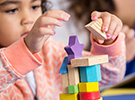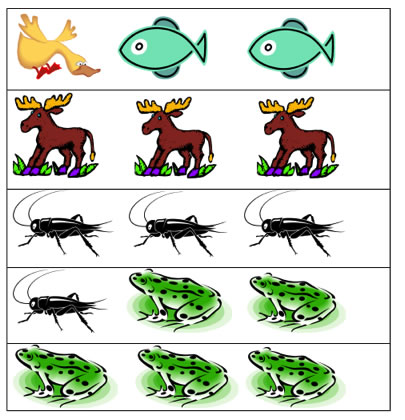One Duck Stuck
In this lesson, children will read the book and begin to recognize that each number is one more than the one before it and that a growing pattern is a pattern that increases or decreases by a constant difference.
Lesson for:
Toddlers/Preschoolers
(See Step 5: Adapt lesson for toddlers or preschoolers.)
Content Area:
Algebra
Data Analysis and Probability
Numbers and Operations
Learning Goals:
This lesson will help toddlers and preschoolers meet the following educational standards:
- Understand numbers, ways of representing numbers, relationships among numbers and number systems
- Understand meanings of operations and how they relate to one another
- Understand patterns, relations and functions
- Develop and evaluate inferences and predictions that are based on data
Learning Targets:
After this lesson, toddlers and preschoolers should be more proficient at:
- Developing understanding of the relative position and magnitude of whole numbers and of ordinal and cardinal numbers and their connections
- Understanding the effects of adding and subtracting whole numbers
- Recognizing, describing and extending patterns such as sequences of sounds and shapes or simple numeric patterns and translating from one representation to another
- Analyzing how both repeating and growing patterns are generated
- Discussing events related to students’ experiences as likely or unlikely

One Duck Stuck
Lesson plan for toddlers/preschoolers
Step 1: Gather materials.
- The book, One Duck Stuck, by Phyllis Root
- Pocket chart or chart paper
- 55 small squares of paper or sticky notes
- Snap cubes
- Scissors and glue
- Animal images from the book, One Duck Stuck

Note: Small parts pose a choking hazard and are not appropriate for children age five or under. Be sure to choose lesson materials that meet safety requirements.
Step 2: Introduce activity.
- Show the class the book, One Duck Stuck. Look at the cover and let some of the children make predictions about the story before you begin reading.
- As you read the book, stop and talk about the animals who are trying to help and count them on each page. After the four crickets come to help, stop reading and ask the children: “What animal do you think will come next?” Field their responses and keep track of the animals that they predict. Then ask: “How many do you think will come?” Again, write down their predictions. The next page will reveal that five frogs come to help. Talk about the children’s predictions. For the children who guessed that five animals would come, ask: “How did you know?”
- Continue to read, stopping one or two more times to let the children predict and then discussing their predictions.
Step 3: Engage children in lesson activities.
- Give each child or pair of children 55 snap cubes of the same color. Explain that you are going to read the story again and that they are going to make a cube train for each animal in the story.
- Start reading and put one square or sticky note in the bottom row of the pocket chart and have the children take one snap cube for the duck.
- Next, place two squares next to the first one on the last row and next-to-last row of the pocket chart. Have the children make a stack of two cubes and place it next to the single cube.
- Continue reading and making the stacks until all 10 are made. When all of the cubes are lined up, smallest to largest, the cube trains should look like a triangle.
- Ask the children to look at both of their cubes and the chart that you have made. Ask: “What do you notice?” (Triangle, stairs) Point out that the train increases by one each time. Ask: “What would happen if, instead of all of the animals working together, a new animal, like a dog, came to help? How many would need to come?” Explain that they are able to predict because the story follows a pattern. Explain that this is a growing pattern because the numbers get bigger each time and always by one.
- Explain that, if 13 dogs came instead of 11 dogs, it would not follow the pattern, because that would be three more, instead of one more. If 13 animals came next instead of 11, it would not follow the pattern, because then there would be three more, instead of one.
- Give each child a piece of construction paper, a copy of the animal pictures from the book, scissors and glue. Each child should cut the animal pictures apart and then glue them to the construction paper to recreate the growing pattern.
- Individually ask the children to tell you about their papers.
Additional Extensions
- Work backwards in the book. After increasing the number of animals that come to help, decrease the number of animals by inventing an extension to the story. Once the story is done and the children have their triangle-shaped cube train, tell the children that the animal’s parents are calling them for dinner. Using the snap cubes and the squares or sticky notes, continue the pattern in descending order. The cube train should look like a pyramid when you are finished.
Step 4: Vocabulary.
- Growing Pattern: A pattern that shows an increasing or decreasing sequence and is used to help children analyze mathematical changes (e.g., “This is a growing pattern because the numbers get bigger each time and always by one.”)
- Predict: To guess what will happen next (e.g., “Can you predict how many animals will come next?”)
- How many: The total or sum (e.g.,”Can you predict how many animals will come next?”)
- Increase: Get larger in size or number (e.g.,”The train increases by one each time.”)
Step 5: Adapt lesson for toddlers or preschoolers.
Adapt Lesson for Toddlers
Toddlers may:
- Struggle with the concept of growing patterns
Child care providers may:
- Read the book more slowly and, when it comes times to add snap cubes, put the book down and help the children add the correct number of cubes and line up their cubes in ascending order
- Help the children line up the animals in the right order, reinforcing the concept of a growing pattern
Adapt Lesson for Preschoolers
Preschoolers may:
- Already understand the concept of a growing pattern
Child care providers may:
- Work backwards in the book. After increasing the number of animals that come to help, decrease the number of animals by inventing an extension to the story. Once the story is done and the children have their triangle-shaped cube train, tell the children that the animals’ parents are calling them for dinner. Using the snap cubes and the squares or sticky notes, continue the pattern in descending order. The cube train should look like a pyramid when you are finished.
Suggested Books
- One Duck Stuck by Phyllis Root (New York: Candlewick, 2003)
Music and Movement
- Sing songs about numbers, such as “This Old Man” or “One, Two, Buckle My Shoe.”
- Sing songs that add one word or action to each verse, such as the following chant: “Hey, my name is Joe and I work in a button factory. I’ve got a wife and a dog and a family. One day the boss came up and said to me: ‘Hey Joe, are you busy?’ I said no. He said: ‘Turn the button with your _____.’” Repeat the verse six times. Continue to do each action as you add a new one: 1. left hand 2. right hand 3. left foot 4. right foot 5. bottom 6. tongue.
Outdoor Connections
Growing patterns is a great cross-curricular theme, especially in science. To witness, analyze and chart how an object changes over a period of time is a comprehensive way in which children can link science and mathematics. Plant a garden from seeds. Sprout the seeds indoors (bean plants are good for this). Observe and chart their growth. Once the seedlings are planted, have the children measure and chart their growth. Keep the plant for the entire cycle and, when the plant dies, recycle the plant back into the ground.
Comment on this lesson